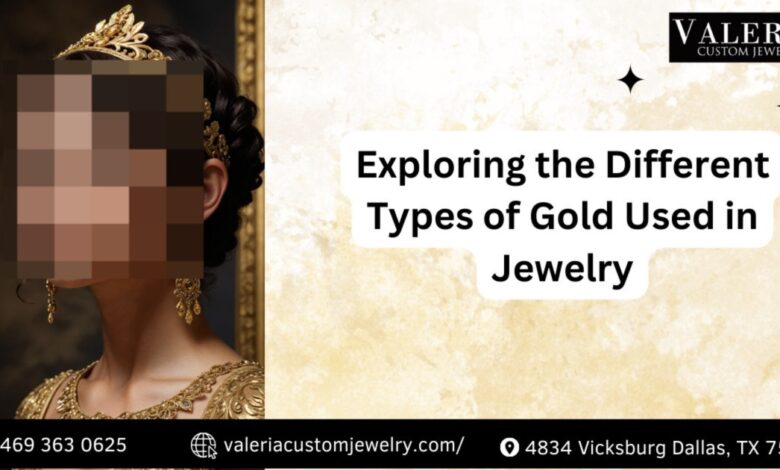Exploring the Different Types of Gold Used in Jewelry

Gold has been a symbol of wealth, luxury, and beauty for centuries. It is one of the most popular materials used in jewelry making due to its stunning appearance, versatility, and ability to retain its value. However, not all gold jewelry is created equal. The type of gold used can significantly affect its price, durability, and overall appearance. In this article, we’ll explore the different types of gold used in jewelry, from solid gold to gold-plated pieces, so you can make an informed decision when purchasing your next piece of jewelry.
1. Solid Gold
Solid gold is the purest form of gold used in jewelry, but it is rarely 100% pure. This is because pure gold is too soft to withstand everyday wear and tear. To make it more durable, pure gold is usually alloyed with other metals like copper, silver, or zinc. The purity of gold is measured in karats, with 24-karat gold being the purest form, containing 99.9% gold. Here’s a breakdown of the common karat levels used in solid gold jewelry:
- 24k Gold: The purest form of gold, but also the softest and most prone to scratching and bending.
- 22k Gold: Contains 91.7% gold and is more durable than 24k but still relatively soft.
- 18k Gold: Contains 75% gold and is widely used in fine jewelry due to its balance of durability and purity.
- 14k Gold: Contains 58.3% gold and is one of the most popular choices for everyday jewelry because of its strength and affordability.
- 10k Gold: Contains 41.7% gold and is the most durable and affordable option, though it has a slightly duller appearance than higher karat levels.
Solid gold is ideal for those looking for a long-term investment piece that will hold its value over time. However, it is more expensive than other types of gold jewelry.
2. Gold-Filled Jewelry
Gold-filled jewelry is a more affordable alternative to solid gold, but it still offers a substantial amount of gold content. In gold-filled jewelry, a thick layer of gold is mechanically bonded to a base metal, such as brass or copper. Unlike gold-plated jewelry, which has a thin gold layer, gold-filled jewelry contains about 5% gold by weight.
Gold-filled pieces are more durable than gold-plated jewelry and can withstand daily wear without tarnishing or flaking. While they are not as valuable as solid gold, gold-filled items offer an excellent balance between quality and affordability.
3. Gold-Plated Jewelry
Gold-plated jewelry is an even more budget-friendly option, offering the look of gold without the high cost. In this type of jewelry, a thin layer of gold is electroplated onto a base metal, such as brass, copper, or stainless steel. The gold layer in gold-plated jewelry is typically very thin—often less than 1 micron thick—which makes it more susceptible to wear and tear over time.
Gold-plated jewelry is ideal for fashion-conscious individuals who want to enjoy the appearance of gold without the investment. However, because the gold layer is so thin, gold-plated pieces can tarnish or fade more quickly, especially with frequent wear. If you’re interested in customizing your gold-plated pieces, consider a custom necklace pendant for a personal touch without breaking the bank.
4. Rose Gold
Rose gold has become increasingly popular in recent years due to its warm, pinkish hue. This type of gold is an alloy made by mixing pure gold with copper. The higher the copper content, the deeper the rose color. Rose gold is available in various karat levels, with 18k and 14k being the most common.
Rose gold is prized for its romantic and vintage appeal. It is more durable than yellow or white gold because copper is a strong metal. This makes rose gold an excellent choice for engagement rings and other pieces that are worn daily. However, it’s important to note that individuals with copper allergies may experience skin irritation when wearing rose gold jewelry.
5. White Gold
White gold is another popular option for those who prefer a sleek, modern look. It is made by alloying pure gold with white metals like palladium, nickel, or silver. To enhance its bright, silvery appearance, white gold is often plated with rhodium, a metal that adds shine and durability.
White gold is a great alternative to platinum, offering a similar appearance at a more affordable price. However, the rhodium plating can wear off over time, especially with frequent wear, so white gold jewelry may need to be re-plated periodically to maintain its shine.
6. Green Gold
Green gold is a unique and rare type of gold that has a subtle greenish tint. It is created by alloying pure gold with silver or cadmium. While green gold is not as widely used in modern jewelry, it can be found in antique and vintage pieces.
Green gold is prized for its distinct and unconventional color. It’s often used in combination with other metals to create striking two-tone or multi-tone jewelry designs.
7. Gold Vermeil
Gold vermeil (pronounced “ver-may”) is a type of gold-plated jewelry that uses sterling silver as the base metal. For a piece to be considered vermeil, the gold layer must be at least 2.5 microns thick and plated over high-quality sterling silver. This makes gold vermeil more durable and valuable than standard gold-plated jewelry.
Gold vermeil is a great option for those looking for high-quality, affordable gold jewelry. It offers the appearance of solid gold without the high cost, and because the base is sterling silver, it’s also hypoallergenic.
Customizing Your Gold Jewelry
One of the most exciting aspects of gold jewelry is the ability to customize it to suit your style and preferences. Whether you’re looking for a one-of-a-kind piece or want to add a personal touch to your collection, custom gold jewelry allows you to create something truly unique. If you’re looking for a personalized option, consider a custom necklace pendant or custom gold necklace, which can be tailored to your exact specifications.
Custom gold jewelry is perfect for commemorating special occasions, such as anniversaries or birthdays, and can be designed to reflect your personal taste and style.
Conclusion
When choosing gold jewelry, it’s essential to understand the different types of gold available and how they affect the jewelry’s appearance, durability, and price. Whether you prefer the timeless elegance of solid gold, the affordability of gold-plated pieces, or the unique appeal of rose or green gold, there’s a type of gold jewelry to suit every taste and budget.
For those looking to add a personal touch to their collection, custom gold jewelry offers endless possibilities. From custom gold necklaces to custom necklace pendants, you can create a piece that reflects your unique style and personality. Whatever type of gold you choose, proper care and maintenance will ensure that your jewelry remains beautiful and cherished for years to come. This article is written by The MediaGale





